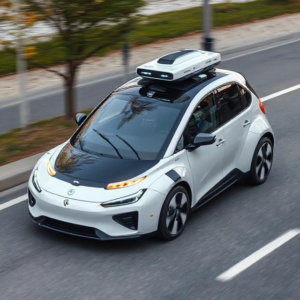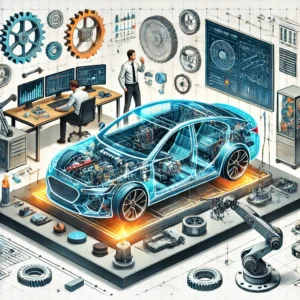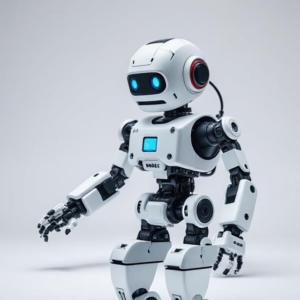What are Autonomous Vehicles?
An autonomous vehicle (also known as a self-driving car) is a vehicle that can drive itself without human intervention. It uses a combination of sensors, software, and algorithms to navigate, make decisions, and drive safely.
The key to autonomous vehicles being able to drive safely and effectively is sensors. These sensors gather information about the car’s surroundings, which the vehicle uses to understand its environment, detect obstacles, and make decisions in real time.

Why are Sensors Important for Autonomous Vehicles?
Sensors are crucial because they provide the data that helps the car understand the world around it. Without them, the car wouldn’t be able to see, hear, or sense anything happening around it, making it impossible to drive safely.
Types of Sensors in Autonomous Vehicles
Autonomous vehicles use several different types of sensors to gather data. Each sensor has a different role, and by combining the data from all these sensors, the car gets a complete picture of its environment.
1. LiDAR (Light Detection and Ranging)
- What is it? LiDAR is a sensor that uses laser beams to measure distances. It shoots out laser pulses and then measures how long it takes for the light to reflect back. This helps the car create a 3D map of its surroundings.
- How does it help? LiDAR can detect objects, obstacles, and road features with high precision, even in low light conditions or at night.
- Example: Imagine you’re driving in a foggy area—LiDAR can still help the car “see” the road ahead by mapping out the surroundings, even when vision-based sensors like cameras might struggle.
2. Radar (Radio Detection and Ranging)
- What is it? Radar uses radio waves to detect objects and measure their distance, speed, and direction. It works by sending out radio waves and measuring how they bounce back from objects.
- How does it help? Radar is great for detecting moving objects (like other cars) and is not affected by weather conditions such as rain, fog, or snow.
- Example: Radar can help detect the car ahead and measure how fast it’s moving, which helps the autonomous car adjust its speed to keep a safe distance.
3. Cameras
- What is it? Cameras are used to capture visual information (like a human driver’s eyes). The car uses multiple cameras around it to see and understand its environment, just like how you use your eyes to see the world.
- How does it help? Cameras can recognize things like traffic signs, lane markings, pedestrians, and traffic lights. They help the car make decisions based on visual cues.
- Example: Cameras help the car detect a red traffic light and stop, or recognize a pedestrian crossing the road.
4. Ultrasonic Sensors
- What is it? Ultrasonic sensors use sound waves at a high frequency to detect objects that are very close to the car. They are commonly used for parking and low-speed maneuvers.
- How does it help? These sensors are good for detecting nearby obstacles (like curbs, walls, or other vehicles) when parking or performing low-speed maneuvers.
- Example: When the car is parking, ultrasonic sensors help it sense the distance between the car and obstacles, like walls or other parked cars, and prevent collisions.
5. Inertial Measurement Units (IMUs)
- What is it? IMUs are sensors that measure the car’s acceleration, orientation, and rotation. They help the car understand its movement in space.
- How does it help? IMUs help with things like understanding how the car is turning or when it’s speeding up or slowing down, which is important for safe navigation.
- Example: If the car takes a sharp turn, the IMU can help it track how much the car has rotated or tilted, allowing the system to keep track of the car’s position even when other sensors (like GPS) might not be as accurate.
6. GPS (Global Positioning System)
- What is it? GPS is used to give the car its location on Earth by receiving signals from satellites.
- How does it help? GPS provides the car with a general idea of its position on a map, allowing it to understand where it is in relation to roads, intersections, and destinations.
- Example: GPS helps the autonomous car follow a route and know its exact position on the map, which is essential for navigation and planning the best path.
How Do These Sensors Work Together?
All the sensors in the autonomous vehicle work together to create a comprehensive understanding of the car’s environment. By fusing the data from all the sensors, the vehicle can:
- Detect objects in its path
- Understand road conditions
- Make safe driving decisions in real-time
This combination of sensor data is then processed by the vehicle’s computer system, which uses algorithms and artificial intelligence (AI) to make decisions, just like a human driver would.
Example of Sensor Fusion:
- Radar detects a car ahead that’s slowing down, while LiDAR creates a 3D map of the surroundings.
- Cameras might detect a stop sign, while the IMU senses that the car is about to make a turn.
- The GPS gives the car its location on the map, helping it know where it is and which direction to go.
Together, all this information helps the car understand where it is, what’s around it, and how to drive safely.
Challenges with Sensors in Autonomous Vehicles
- Weather and Lighting Conditions:
- Some sensors, like cameras, can struggle in poor weather (rain, snow, fog) or low lighting (nighttime). That’s why multiple types of sensors (like LiDAR, Radar, and cameras) are used to cover for each other’s weaknesses.
- Sensor Accuracy:
- Sensors need to be highly accurate because even a small error in detecting obstacles or road features can lead to a dangerous situation.
- Cost and Complexity:
- The more sensors an autonomous vehicle has, the more expensive and complex the system becomes. It’s important to balance the cost of sensors with the performance and safety benefits they provide.
Summary
- Autonomous vehicles rely on multiple sensors to understand the environment around them and make driving decisions.
- These sensors include LiDAR, Radar, Cameras, Ultrasonic sensors, IMUs, and GPS.
- By using data from all of these sensors together, the vehicle can navigate safely and avoid obstacles, just like a human driver would.
- While sensors help the car see, understand, and navigate, challenges like weather, accuracy, and cost must be carefully managed to ensure safe and effective self-driving cars.











